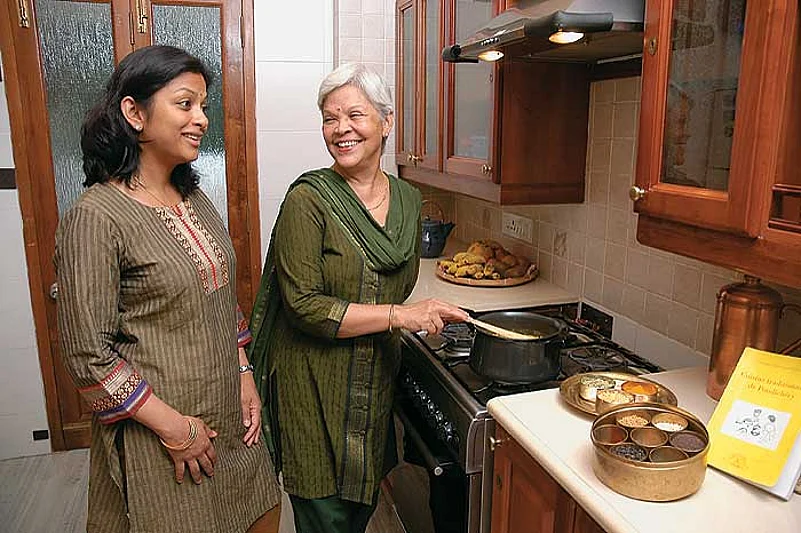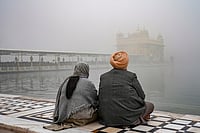Do we live to eat, or eat to live? Ask Pierre Elloard, who runs Satsangha, a landmark gourmet restaurant in Pondicherry, and pat comes his answer: “Indians are capable of eating the same thing everyday but with the French, food is a passion, a way of life.” Find that a bit hard to swallow? Yet, whatever the apparent differences—gastronomic or attitudinal—French and Indian food have managed to find a meeting-ground in this former French enclave.
That food, call it Pondicherrian or Franco-Pondicherry cuisine or Pondicherry Dubash, has been this union territory’s best-kept secret. Cooked in 60-odd homes, it has largely remained within the confines of families that trace their ancestry to that time, three centuries ago, when the French first arrived here as colonisers. Decades after they left, the French influences are everywhere—in the buildings, the Latin Quarter, the red hats worn by policemen, the use of the French language, the popularity of the game Petanque. But strangely, none of the former enclave’s chic restaurants, catering to a steady stream of tourists, serve Pondicherrian cuisine—the food that evolved when Tamil spices met French food.
Not so strange, actually. The recipes have been zealously guarded, and they are also the preserve of families that were, typically, conservative, reclusive and lacking the entrepreneurial spirit to go commercial with their food. But the dishes are delectable, some comparable with the more famous food of Chettinad; others with French food, but a far from bland version, spiked with the zing of green chillies and flavoured with garlic, bay leaf and star anise. It came about, apparently, because French kitchens here were run by locals who adapted the food to make it edible for themselves, and also because they had to make do with local ingredients.
Take the popular French soup, bouillabaisse, made with fruits de mer (fruits of the sea) like fish, crabs, shrimps and flavoured with pepper. In the hands of the Pondicherrians, it has turned into pouillanbaisse, which has everything its French counterpart has, but with ghee, green chillies, bay leaf, cinnamon, carrots, beans, potatoes, turmeric and coconut milk thrown in! The same goes for giogot daube, mutton baked with pepper. In the local version, the mutton is cooked first, then fried with garlic and onions, roasted and finally, cooked again. Tomato, a favoured ingredient in most Indian cooking, is used sparingly. But lime provides its share of sourness, as in the delicious apazha meen roast (lime fish roast). There’s also a Pondicherrian version of poulet roti (chicken roast), a favourite at festivals, and turkey (vangozhi) is a must at Christmas or Easter. “I remember my mom made it for my first holy communion,” reminisces Sandhya Petizon-Louis, a Paris-based business consultant who grew up in Pondicherry.
Hearteningly, the food of the Pondicherrians does have its lone chronicler and record-keeper—in no other than Sandhya’s mother, Lourdes Tirouvanziam Louis, who still lives in Pondicherry with her doctor husband Bernard. Author of Cuisine traditionelle de Pondicherry, the only proper recipe book on the cuisine, she recalls that the 350-page book flew off the shelves when it came out in 2003. So popular was it with members of the Pondicherrian diaspora that she wasn’t even left with a copy of her own.
Sandhya recalls laughing: “When my brother and I shared an apartment in Paris while we were studying, we would get homesick for mom’s cooking and keep calling her for recipes.” That’s when Lourdes decided to get computer-savvy and keyed in all those recipes that form the basis for her book, among them favourites such as langouste curry and avarakkai saladu. The book wasn’t written just for her children, though. “What really propelled me to write it was my desire to safeguard the cuisine,” says Lourdes.
That desire still galvanizes her. In a few weeks, her second 550-page Pondicherrian cookbook will be out, containing recipes from her earlier book, along with new ones, painstakingly acquired and added. “I travelled to Karaikal, 140 km away, to meet old Pondicherrian families to find traditional recipes. Some kicked me out, while others gave me tattered recipes and asked me to sit there and copy them.”
Lourdes’s visits to Pondicherrian homes helped her understand, she says, why the cuisine continues to be the preserve of a few families. Some, she recounts, attacked her for revealing family secrets, others left out ingredients that transform a dish from ordinary to lip-smacking. Explains sociologist Dr Animesh Rai, who has studied various aspects of this community: “The French-Pondicherrians are not easily accessible, and do not give out information about themselves readily. The marginalisation of this cuisine reflects the marginalisation of the community in general.”
But when Lourdes’s cookbook came out, some families did receive it positively, she said, seeing it as a way of passing on their cooking traditions—in danger of becoming extinct—to their children abroad. Meanwhile, news of her cookbook found its way to Praveen Anand, executive chef at Sheraton Park Hotel & Towers in Chennai, who was inspired to recently put together a festival of Franco-Pondicherry food at the hotel. A fan of the cuisine, he says: “Unlike Indian food, where we drown the natural taste of meat and vegetables with masala, Pondicherrian food is very evolved.” With growing awareness of the interest of “outsiders” in the cuisine, Lourdes is now translating her first cookbook, originally written in French, into English and Tamil; the second one, also in French, will be translated too, eventually. Interest in the cuisine has also prompted Pierre, who thinks the recipes would need to be despiced considerably to appeal to the Western palette, to plan a Pondicherrian food festival at his restaurant and even, perhaps, introduce a few dishes from the cuisine in his regular menu. Maybe this is a cuisine whose time has finally come.


























